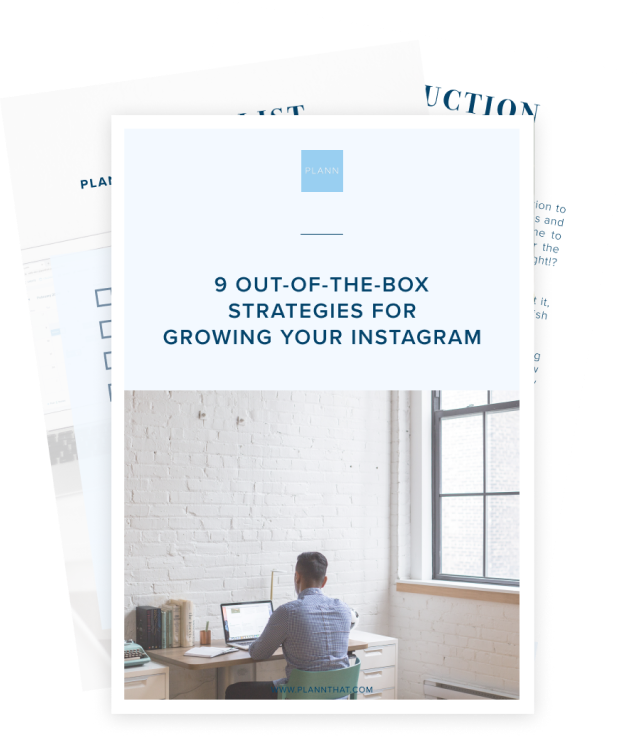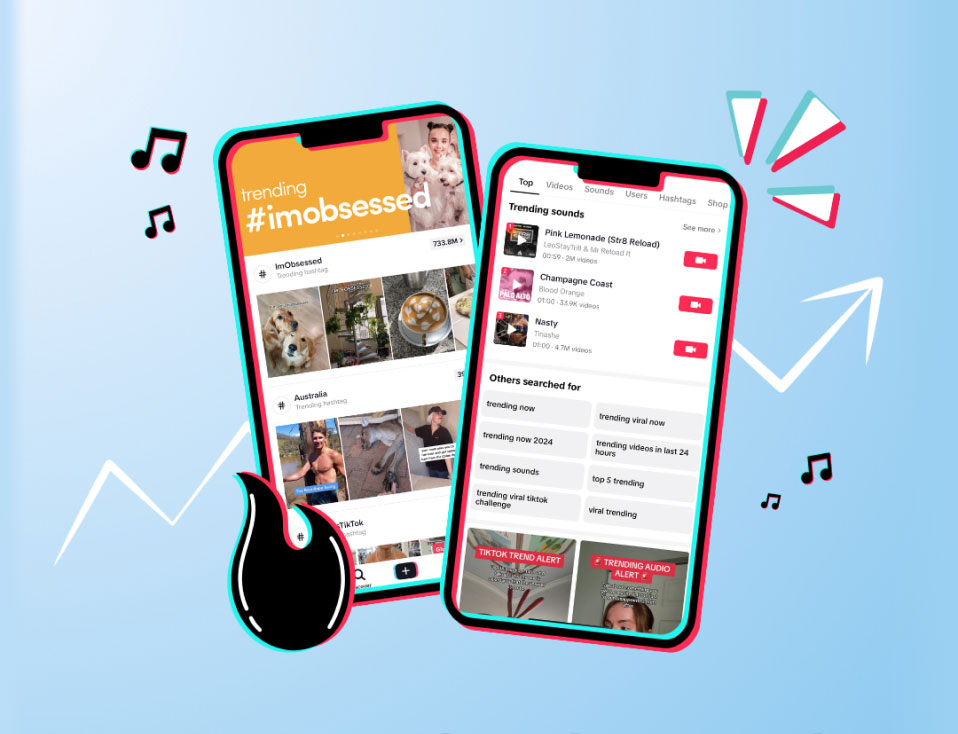It’s hard to believe YouTube only launched in 2005. In the years since, the video-sharing platform has become ubiquitous, providing our daily fixture of educational and entertaining content.
The popularity of YouTube continues to skyrocket. With more than 2.7 billion active users, over 122 million people visit the platform daily. And when you consider the fact that 1 billion hours of videos are watched on YouTube every day, you begin to think: how do I actually make my content visible?
Rising to the top might feel like an uphill battle, but it is possible. By learning how to tap into YouTube SEO (a.k.a. search engine optimization), you can ensure the YouTube algorithm favors your content in search results. The trick? Understanding what your audience is looking for on YouTube and optimizing every video to target these searchable keywords.
Curious about how to tap into YouTube SEO techniques? We’ve rounded up ten key strategies that will ensure you get seen on YouTube, regardless of your channel size.
What is YouTube SEO optimization?
Recommendations from the YouTube algorithm drive 70% of what people watch on the platform. Not surprisingly, understanding how to use it in your favor is imperative when it comes to gaining subscribers.
By analyzing closed captions, transcripts, titles, descriptions, and tags, the algorithm decides how to rank each video. As well as considering the past activity of the viewer, the algorithm will look at things like the time spent watching a video, whether audiences engaged with it, and their regional context. All of these metrics help the algorithm to deliver search results that feel personalized to the viewer.
That’s where SEO optimization comes in. YouTube SEO refers to the process of optimizing videos so they can rank higher in YouTube’s search results. These strategies focus on how you can attract more organic traffic to your videos and get your content in front of your target audience.
Think of YouTube SEO as your chance to tell the algorithm how relevant, popular, or engaging your video is and how it responds to a user’s search query.
Why is YouTube SEO important for gaining more YouTube subscribers?
A staggering 720,000 hours of video are uploaded to YouTube every day. YouTube SEO is your answer to being seen on this highly competitive platform.
You need eyes on your content to be able to attract new subscribers, and YouTube SEO is an important part of this process. The key benefits of YouTube SEO include:
• Boosts engagement: By using SEO strategies (like optimizing your video titles, descriptions and tags) your content is more likely to be suggested to viewers searching for these keywords. These same viewers are more likely to watch and engage with your other content, thereby increasing your overall engagement on the platform.
• Drives traffic: With strong YouTube SEO strategies, you can get engaged, high-intent viewers clicking through to your website to learn more about what you do best.
• Increases visibility: By optimizing your videos for the YouTube algorithm, you’ll rank more highly, boosting your reach and making it easier for people to find and watch your content.
• Builds brand awareness: With videos that are optimized for YouTube SEO, you’ll be able to reach a target audience interested in your content. As more people engage with your content, brand awareness increases – as does your subscriber base.
Looking for YouTube channel growth tips? Here are ten strategies to boost your YouTube visibility and grow your audience by harnessing video SEO techniques.
1. Conduct keyword research
Ever wondered why a bunch of related terms pop up when you start typing into the YouTube search bar? That’s the important of SEO keywords in action.
These words and phrases are what audiences use when searching for content. At times, YouTube lends a hand with its search bar suggestions. If you want to have your video come up as one of the top results, you need to include these specific keywords when uploading YouTube videos.
Here are the two main types of keywords you need to know:
• Short-tail keywords: these are short phrases (one to three words) that are broad, generic but have high search volume, meaning they’re more competitive to rank for.
- Example: “Vegan Diet”
• Long-tail keywords: these are longer phrases (5+ words) which drill down into a niche topic. While the search volume is lower, these keywords are less competitive to rank for and help you target a more refined audience group.
- Example: “15-minute Savoury Vegan Breakfast Ideas”
Keyword research allows you to understand your target audience and what it is they are searching for. Consider using keyword research tools like Keyword Analytics for YouTube, which allows you to see how many searches certain keywords get and how competitive they are.
YouTube’s auto-complete function also reveals the popular searches related to the query you are typing. You can also find keywords by typing the topic of your video or channel into the YouTube search bar and taking the relevant search terms that come up as autocomplete results.
2. Describe your video content
Once you have your keywords, be sure to use them in the video title, description, tags, title cards, and text overlays. You can also include some keywords in video chapters and the video script itself.
Keep in mind that viewers head to YouTube with the intention of watching content. They don’t want to read an essay, no matter how poetic it might be! So, aim for concise descriptions craft with your viewer’s needs in mind.
Remember: 70% of search queries are made up of long-tail keywords, so it’s worth using them in video descriptions or video tags to target niche, high-intent audiences.
3. Include timestamps
Ever clicked on a YouTube video only to find yourself desperately trying to fast-forward to the good parts? That’s where timestamps can help. These clickable markers act as chapters that describe what to expect from each section of your longer YouTube videos.
As far as YouTube SEO goes, it’s a helpful tool to boost video ranking as it helps the platform understand the content of your video.
If someone searches a particular phrase that’s been used as a timestamp in your video, Google search results will show your video with the corresponding timestamp. This improves the viewer’s experience, serving them the right section of your video to answer their search query.
Take the example of dating coach Matthew Hussey who has built a following of 2.9 million on his YouTube channel. With clearly outlined timestamps that speak to a viewer’s queries, Hussey is able to direct audiences to his channel should they search keywords like “breakup” or “dating advice” on Google.
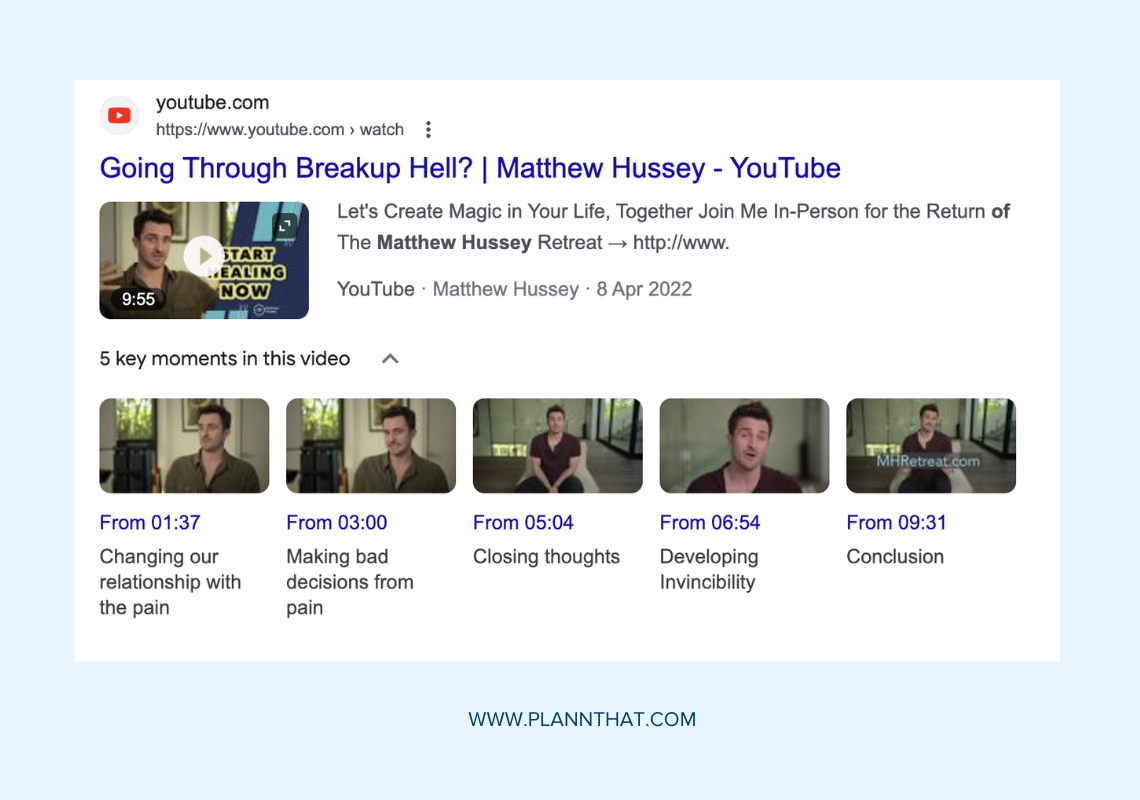
4. Harness hashtags and categories
Just like an Instagram post uses hashtags to increase its reach, you can also do the same on YouTube. Hashtags show up above the video title and allow viewers to easily discover your content.
Whether you opt for your company name or SEO keywords, hashtags boost discoverability on YouTube. That being said, be select as YouTube frequently checks for spam and may deprioritize your content if you overuse hashtags.
Our tio? Keep hashtags confined to two to four strong tags that are relevant to your content and your target audience. They should describe your video succinctly. Take the example of Haley Kim’s makeup tutorials. In this video on best-tinted moisturizers, she uses the hashtags #skintint, #makeup, and #naturalmakeup in the description to draw in viewers.
Categories are also a valuable SEO tool for YouTube videos and allow you to present your video as part of a broader topic. If it’s a review of the new iPhone, use the category of “Technology”. If you’re providing lessons on the correct technique for a tennis serve, opt for “Sport”.
These categories are selected at the time of uploading and help YouTube better understand the content of your video, making it more likely to appear higher in search results.
5. Follow YouTube thumbnail best practices
We all spend time choosing the perfect profile picture, and the same should be said for your YouTube thumbnail image.
The best thumbnails stand out with strong visuals, clear text overlays and a branded look and feel.
According to YouTube, thumbnails should have the following requirements:
• A resolution of 1280×720 (minimum width of 640 pixels)
• Be uploaded in formats like JPG, GIF, or PNG
• Be under 2MB for videos or 10MB for podcasts
Still on the fence about the need for a strong thumbnail image?
YouTube sensation MrBeast carried out his own test to determine what made for a more successful picture. Turns out, thumbnails featuring closed mouths actually increase viewer watch times compared to those that feature open mouths and shocked expressions.
It’s a big revelation when it comes to SEO, as greater watch time and more views greatly increase your ranking and help to gain subscribers.
Seems like it, here’s more results. Now that I can actually A/B test thumbnails I don’t have to guess and I just test and see what people want. My mouth would have closed years ago if I had this tool 😭 pic.twitter.com/KelQC9tDkf
— MrBeast (@MrBeast) September 6, 2023
6. Curate video playlists
Organizing your videos into keyword-optimized playlists has two benefits for YouTube SEO. First, it helps the platform understand what topics your channel covers. Secondly, it helps viewers navigate your content more easily, as they can search by topic or find videos related to their search queries.
Because the algorithm favors videos with higher watch time and session duration, video playlists can help you boost organic visibility on YouTube.
The best part of playlists is that they auto-play to the next video, encouraging viewers to stay on your page and consume more content. This contributes to a longer overall session time and, ultimately, a boost in your video views.
The key to building playlists is to ensure they use keywords for their title. It also goes without saying that videos in each playlist need to relate to this. Another way to organize a YouTube playlist is to arrange videos by series.
Take Grow with Anna as an example. With an audience of fitness enthusiasts of all levels, Anna uses playlists to highlight specific workouts based on fitness level, body focus, and intensity, making it easy for audiences to find the content best suited to their needs.
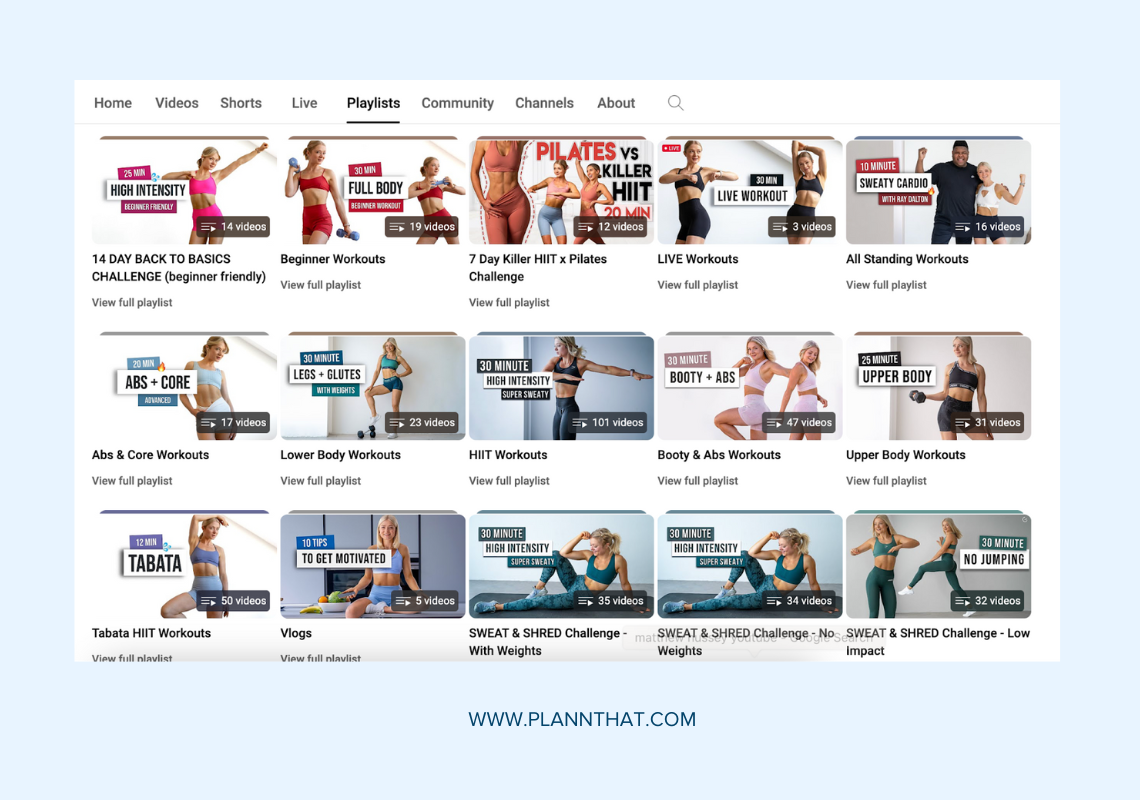
7. Use cards and end screens
If you’re unfamiliar with YouTube cards, these are the little boxes you might see pop up in a video, asking you to subscribe or directing you to another video related to the content.
Fun and engaging, cards are a great way to grow subscribers as you drive viewers to more of your content. The best part is that if the viewer clicks the card, the video associated with it appears alongside the current video. So they’re not being directed away from your content but rather encouraged to consume more from your channel.
With cards, you decide when you want them to appear in the video. It’s recommended you aim for the card to pop up when the content coincides with something mentioned in the script. Maybe it’s a call to action, like “If you enjoyed this video, check out my others on this particular topic”.
End screens serve a similar purpose, only they appear in the last 5-20 seconds of a video. This feature is an opportunity for you to encourage viewers to subscribe or direct them to more of your content or a popular playlist.
Check out the end screen of dermatologist Dr Sam Ellis. She features a call to action for subscribers, as well as another related video to encourage viewers to stay on her channel.
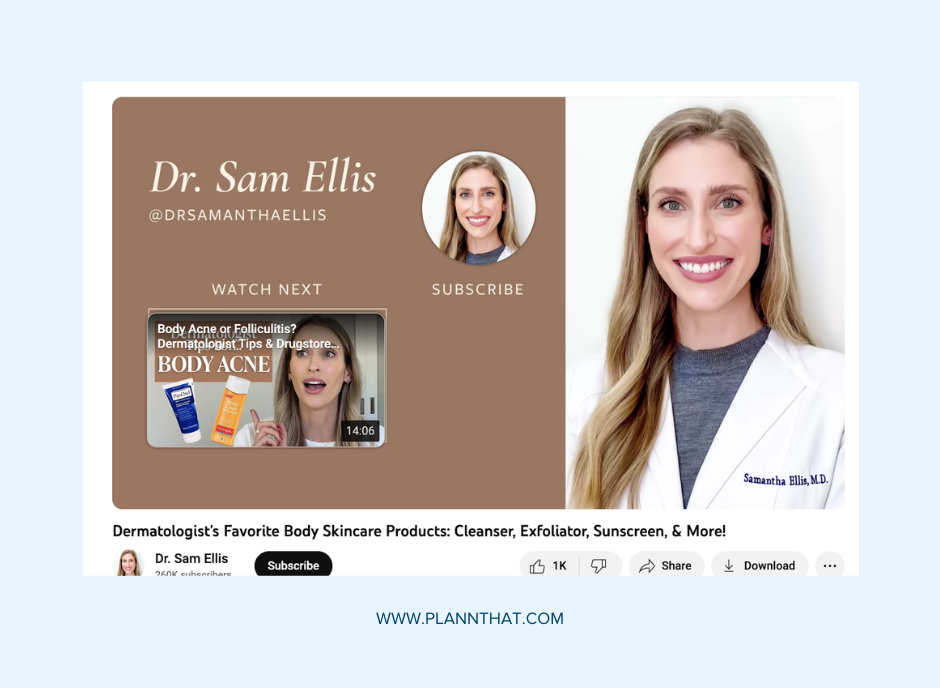
8. Add a call to action to inspire engagement
Much like the function of an end screen, having a call to action in your videos is crucial when it comes to engaging audiences and growing your subscriber base. Whether this is incorporated in your script or a card on the screen, a call to action asks something of your viewers.
A compelling call to action invites your viewers to do something. This isn’t confined to commenting on a video but can take various shapes. Some great calls to action include:
• Subscribe: Asking viewers to subscribe to your channel is a great way to grow your audience. They’ll get notified when you post new content, with most of them watching it a day or two from publishing.
• Watch next: Suggest another video to keep audiences engaged with your channel. This can be related to the current video or in keeping with the series.
• Like and share: Frequently, you’ll hear creators asking viewers to “hit that like button.” With the algorithm favoring videos that have a higher number of likes, this is a great way to rise above the competition.
• Follow on social media: When it comes to raising brand awareness, directing viewers to your website or social channels allows them to see more of your content.
• Comment: Inviting people to leave a comment helps boost engagement on your videos. You can also foster a sense of community by pinning and replying to comments.
• Read the description: If you’re looking to share extra information and resources, invite viewers to read the description, where you can paste links relating to the video.
• Visit our website or link in bio: If you’re looking to increase revenue, directing viewers to a website can help drive traffic.
Check out this video from Gaz Oakley as he presents a call to action for viewers to purchase a copy of his book while also inviting them to comment on what videos they’d like to see more of.
Calls to action help increase engagement as they get people to participate, whether that’s writing in the comments section or rating the video itself. By combining it with an end screen or link to other content, you can also increase the time viewers spend on your channel, thereby boosting watch time.
9. Add closed captions
Videos that are accessible to all are naturally going to draw a wider audience. That’s what makes closed captions ideal for growing a subscriber base.
If you thought it was something that only benefited those with hearing impairments, studies have found that 80% of people watch a video when captions are available. The fact is, closed captions also provide context for audiences who might miss something in the audio.
Another benefit of using captions is that they allow you to include important keywords that the YouTube algorithm can pick up on.
The best way to add captions to your videos is to do it manually by uploading a text transcript or timed subtitles file. You can also let YouTube generate automatic captions for your video which you can jump in and edit to remove inaccuracies.
10. Embed videos across your site
Did you know embedding your YouTube videos on your site can boost your ranking in Google?
Cross-promotion is a valuable tool in the world of SEO and can lead to an increase in traffic and rankings for both your YouTube channel and website. Research shows that embedding YouTube videos can double or triple the number of keywords on the first page of Google’s search results. This increase in site impressions equates to more brand exposure and more subscribers.
When embedding your YouTube videos, be sure that the video content is relevant to the URL and keywords that it’s linked to. This generates greater trust with your audience and increases engagement.
With these strategies, you’ll have grown your YouTube subscriber count in no time, all while increasing brand awareness. Once you’ve got your content mapped out, consider using a tool like Plann’s all-in-one content suite to get your YouTube content sorted with ease.
Go on, and redeem your 7-day free trial of Plann Plus. If you don’t like it, keep using Plann for free!


